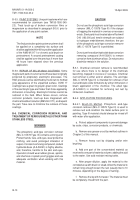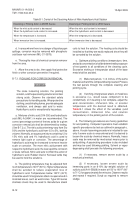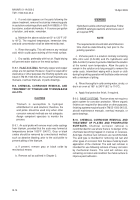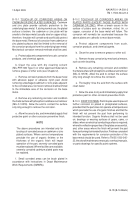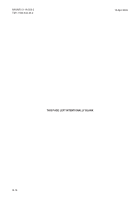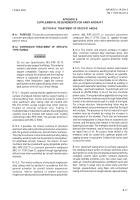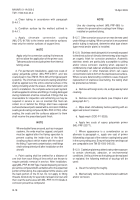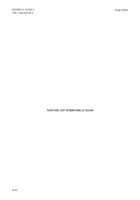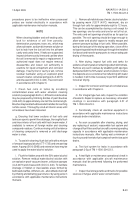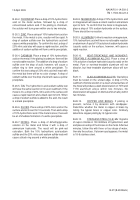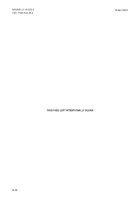TM-1-1500-344-23-2 - Page 221 of 240
NAVAIR 01-1A-509-2
TM 1-1500-344-23-2
15 April 2009
c. Wipe thoroughly with an approved solvent cleaner.
d. Apply wash (DOD-P-15328).
e. Apply two coats of epoxy MIL-DTL-53022
(corrosion inhibitor, lead and chromate free).
f. As an alternate to paragraph e., apply one coat of
primer followed by a topcoat to match surrounding area.
Ensure that the primer and topcoat are compatible (see
TM 55-1500 345-23).
B-13. CORROSION REMOVAL FROM THIN
METAL.
When corrosion and stains are to be removed from
airframe structure skins thinner than 0.0625 inch and an
abrasive method of removal is required, the following
procedure applies:
a. Prepare pumice paste by mixing pumice powder
(SS-P-821) and water to form a slurry. Use a clean, soft
cloth such as cheesecloth to apply the paste to the stain
and rub gently.
CAUTION
Do not allow metallic or corrosion particles to
build up on the polishing area or polishing tool
(cloth or grit paper) during polishing. Damage
to the metal may result.
b. When pumice has dried to a white powder, wipe
off with clean, dry, soft cloth. If corrosion products still
exist (stubborn stains), use number 600 grit, wet or dry,
abrasive paper and water to remove the remaining
corrosion. Wipe clean with clean, dry, soft cloth.
B-14. CORROSION AND PAINT REMOVAL FROM
METAL COMPONENTS REMOVED FROM
AIRCRAFT.
Metal components removed from aircraft
(except control surfaces, precision components, and
close tolerance fittings) and taken to repair shops for
routine rework may be cleaned free of paint and corrosion
by abrasive blasting. See Chapter 4 and the specific
alloy sections for detailed information.
B-15. AIR INTAKE DUCTS-JET AIRCRAFT.
Air intake
ducts are fabricated from materials (usually 5000 series
aluminum) which have high corrosion resistance. Certain
components of these ducts may be cast aluminum or
magnesium. Coating of these castings and frequent
cleaning of the duct is usually sufficient to preclude
attack by corrosion. Aircraft performing low level missions
or take-off and landings over salt water or in highly
saline atmospheres may need the ducts painted to
reduce corrosion attack. Such a requirement must be
determined by the operating activity. A polyurethane
paint system as outlined in TM 55-1500-345-23 is
recommended.
NOTE
When the history of an aircraft reveals duct
cracking and rivet shear, a coating is not
desirable. Painting of such ducts will make
detection of failures difficult, and often
impossible, without removal of the paint.
B-16. CLOSELY COILED SPRINGS.
Springs that are
closely coiled, preventing the application of plating to
internal surfaces, shall receive two coats of
MIL-DTL-53022 (corrosion inhibitor, lead and chromate
free) or MIL-PRF-23377.
NOTE
These requirements do not apply to springs
made of corrosion resistant steel or beryllium
copper, or to springs in oil or hydraulic fluids.
B-17. CORROSION TREATMENT OF STEEL
CABLES.
a. Inspect cable for damage in accordance with
TM 1-1500-204-23-1, paragraph 9-12e,
and appropriate
aircraft manuals.
b. Move surface controls of the particular cable to
the extremities to reveal the cable in the pulley contact,
fairlead area, or drum. If the surface of the cable is
corroded, relieve cable tension and carefully force the
cable open by reverse twisting and visually inspect the
interior.
c. Corrosion on the interior strands of the cable
constitutes failure, and the cable must be replaced. If no
internal corrosion is detected, remove loose external
rust and corrosion with a clean, dry, coarse-weave rag
or fiber brush.
d. After thorough cleaning, apply MIL-PRF-16173
Grade 1 corrosion preventive compound sparingly. Do
not apply the material so thick that it will interfere with
the operation of cables at fairleads, pulleys or grooved
bellcrank areas.
B-19/(B-20 Blank)
Back to Top


